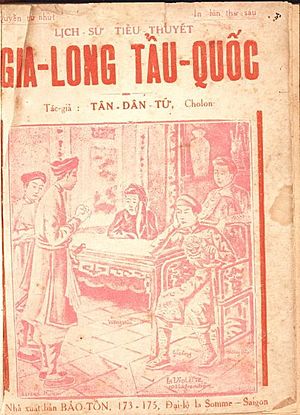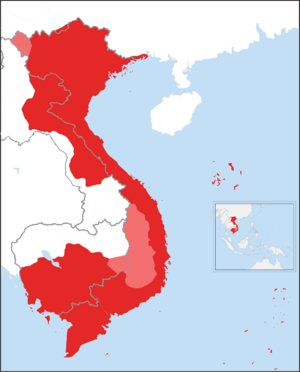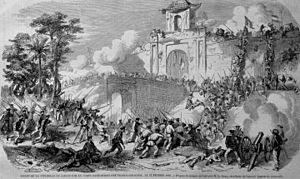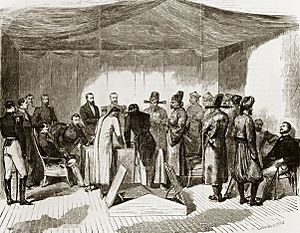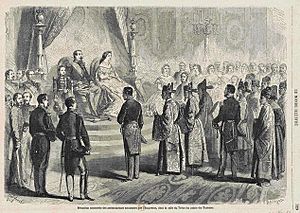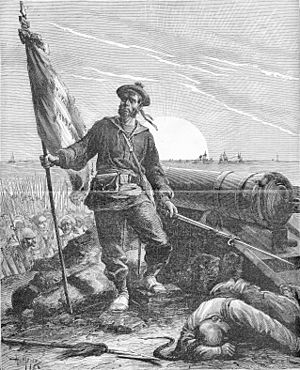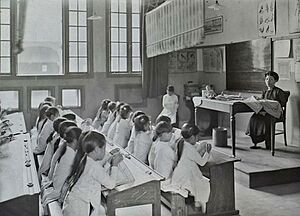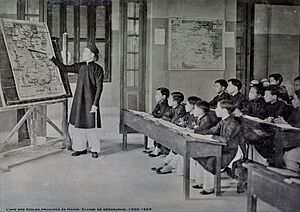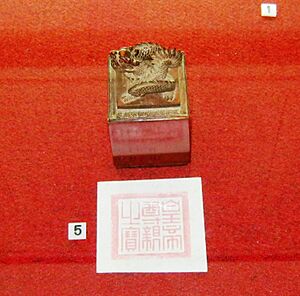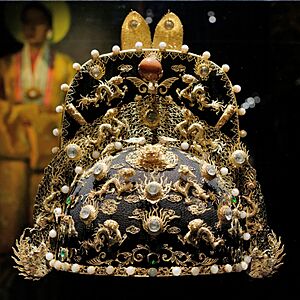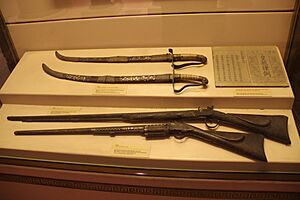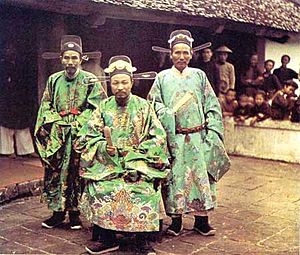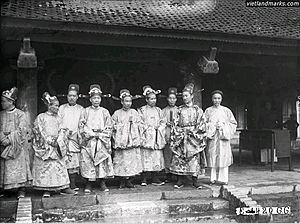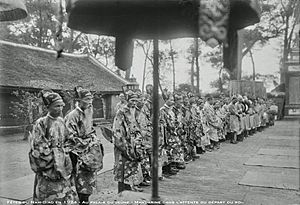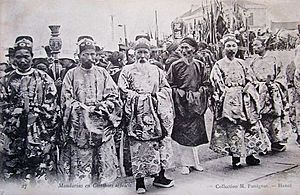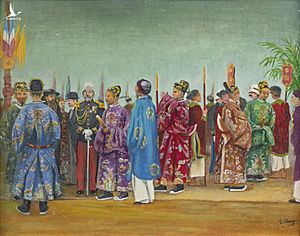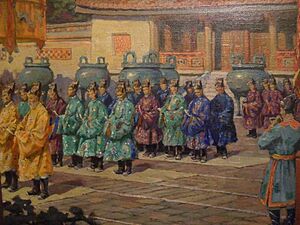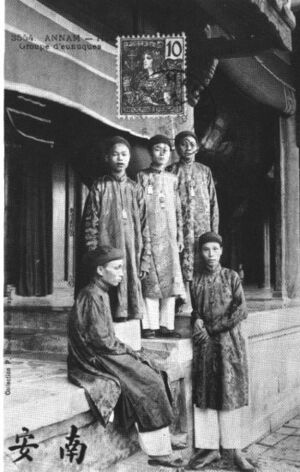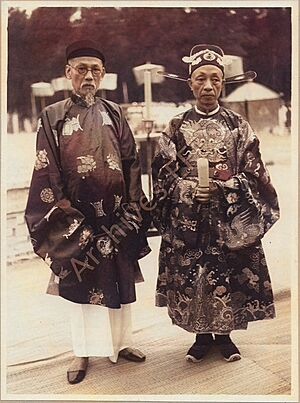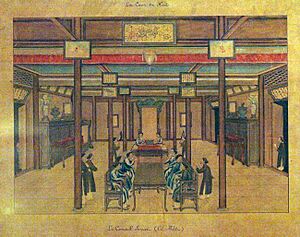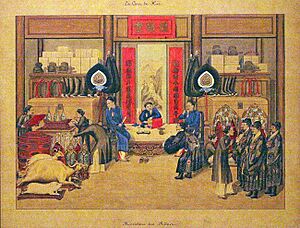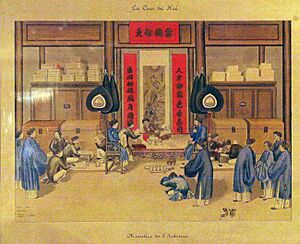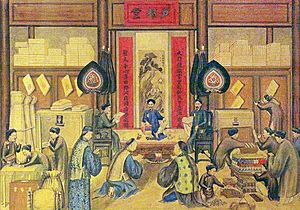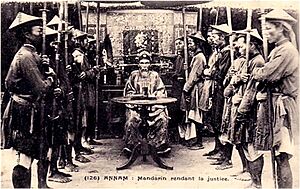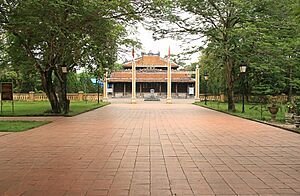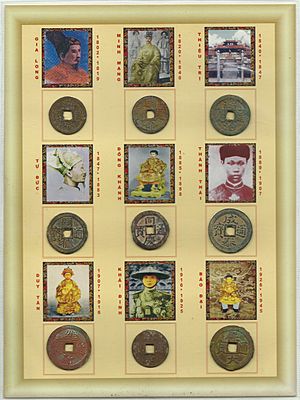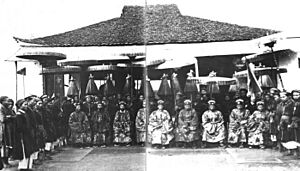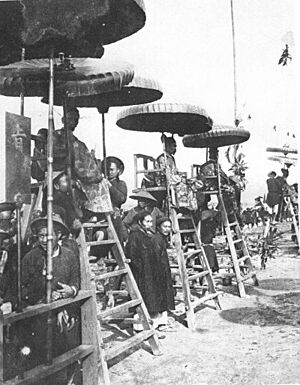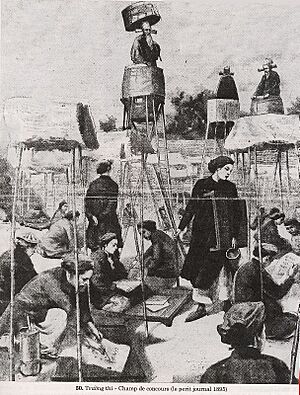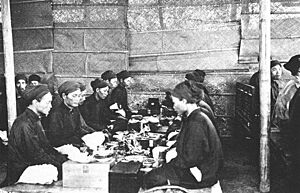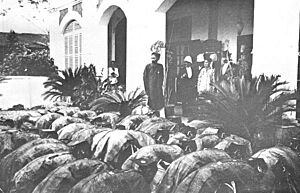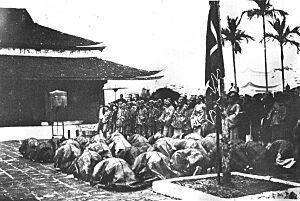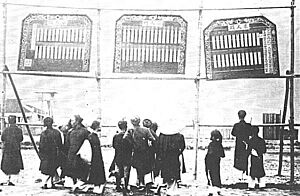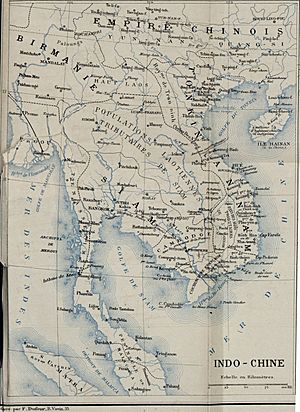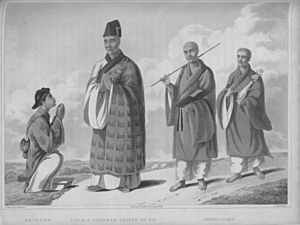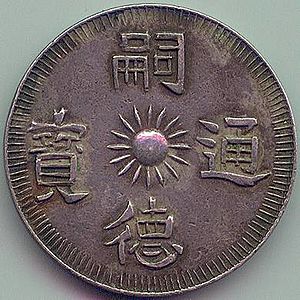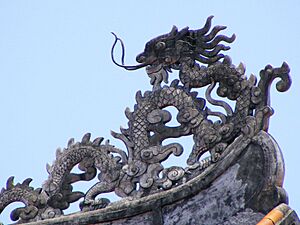Nguyễn dynasty facts for kids
Quick facts for kids
Đại Việt quốc
大越國 (1802–1804) Việt Nam quốc 越南國 (1804–1839; 1945) Đại Nam quốc 大南國 (1839–1945) |
|||||||||||||||||
|---|---|---|---|---|---|---|---|---|---|---|---|---|---|---|---|---|---|
| 1802–1945 | |||||||||||||||||
|
Court flag
(c. 1920s–1945) |
|||||||||||||||||
|
Anthem: Đăng đàn cung
("The Emperor Mounts His Throne") |
|||||||||||||||||

Administrative divisions of Việt Nam in 1838 during the reign of Emperor Minh Mạng.
|
|||||||||||||||||
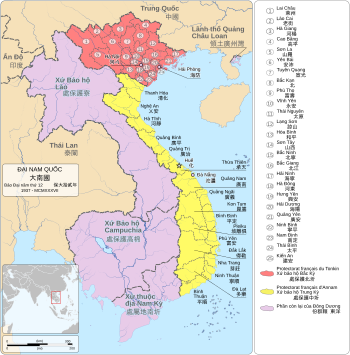
Administrative divisions of Đại Nam (yellow and red) within French Indochina in 1937 during the reign of Emperor Bảo Đại.
|
|||||||||||||||||
| Status | Internal imperial system within Chinese tributary (1802–1883) French protectorate (1883–1945) Puppet state of the Empire of Japan (1945) |
||||||||||||||||
| Capital | Phú Xuân (now Huế) 16°28′N 107°36′E / 16.467°N 107.600°E |
||||||||||||||||
| Official languages | Vietnamese Văn ngôn French (from 1884) |
||||||||||||||||
| Religion | State ideology: Ruism Minority: Mahayana Buddhism, Caodaism, Christianity, Folk religion, Hòa Hảo, Hinduism, Islam, and Taoism |
||||||||||||||||
| Government | Absolute monarchy
|
||||||||||||||||
| Emperor | |||||||||||||||||
|
• 1802–1820 (first)
|
Gia Long | ||||||||||||||||
|
• 1847–1883 (last independent)
|
Tự Đức | ||||||||||||||||
|
• 1926–1945 (last)
|
Bảo Đại | ||||||||||||||||
| Regent | |||||||||||||||||
|
• 1818–1820
|
Minh Mạng | ||||||||||||||||
|
• 1884–1885
|
Tôn Thất Thuyết & Nguyễn Văn Tường | ||||||||||||||||
| Prime Minister | |||||||||||||||||
|
• 1945
|
Trần Trọng Kim | ||||||||||||||||
| Legislature | None (rule by decree) | ||||||||||||||||
| Historical era | Modern era, World War II | ||||||||||||||||
|
• Coronation of Gia Long
|
1 June 1802 | ||||||||||||||||
|
• Tây Sơn defeated
|
20 July 1802 | ||||||||||||||||
| 1 September 1858 | |||||||||||||||||
|
• Treaty of Saigon
|
5 June 1862 | ||||||||||||||||
|
• End of independence
|
25 August 1883 | ||||||||||||||||
|
• Protectorate Treaty
|
6 June 1884 | ||||||||||||||||
| 11 March 1945 | |||||||||||||||||
|
• Abdication of Bảo Đại
|
25 August 1945 | ||||||||||||||||
| Area | |||||||||||||||||
| 1830 | 557,000 km2 (215,000 sq mi) | ||||||||||||||||
| Population | |||||||||||||||||
|
• 1830
|
10,500,000 | ||||||||||||||||
|
• 1858
|
12,031,000 | ||||||||||||||||
|
• 1890
|
14,752,000 | ||||||||||||||||
|
• 1942
|
25,552,000 | ||||||||||||||||
| Currency | Zinc and copper-alloy cash coins (denominated in phần, văn, mạch, and quán) Silver and gold cash coins and ingots (denominated in phân, nghi, tiền, and lạng / lượng) French Indochinese piastre (from 1885) |
||||||||||||||||
|
|||||||||||||||||
| Today part of | Vietnam Laos Cambodia China |
||||||||||||||||
The Nguyễn dynasty was the last royal family to rule Vietnam. They were in charge of a united Vietnam from 1802 to 1945. For most of this time, they ruled independently. However, after 1883, they became a protectorate of France. This means France controlled many of Vietnam's affairs.
During their rule, the Nguyễn dynasty expanded Vietnam's land. They took over parts of what are now Cambodia and Laos. The French later took control of parts of southern Vietnam in 1862 and 1874. By 1883, the Nguyễn dynasty only had power in name. They ruled the French protectorates of Annam (Central Vietnam) and Tonkin (Northern Vietnam).
In 1945, the Nguyễn dynasty briefly declared independence as the Empire of Vietnam. But their rule ended on August 25, 1945, when Emperor Bảo Đại gave up his throne. This marked the end of 143 years of Nguyễn rule.
Contents
- Understanding Vietnam's Names
- The History of the Nguyễn Dynasty
- How the Nguyễn Dynasty Was Governed
- Administrative Divisions of Vietnam
- Society and Culture
- Symbols of the Nguyễn Dynasty
- Images for kids
- Imperial Family
- See also
Understanding Vietnam's Names
The country of Vietnam has had different names throughout history. The Nguyễn dynasty used a few official names during their time.
The Name Việt Nam
The name Việt Nam comes from Nam Việt, which means "Southern Việt". This name goes back to the second century BC. The word "Việt" refers to people who lived south of China.
The name Việt Nam was first written down in the 1500s. In 1802, Gia Long started the Nguyễn dynasty. He asked the Chinese emperor to call him 'King of Nam Việt'. But the Chinese emperor said no. This was because the name Nam Việt was linked to a kingdom that included parts of southern China. So, the Chinese emperor suggested "Việt Nam" instead. From 1804 to 1813, Emperor Gia Long officially used the name Vietnam.
The Name Đại Nam
In 1839, under Emperor Minh Mạng, the empire's official name became Đại Việt Nam, meaning "Great Vietnam". This was later shortened to Đại Nam, which means "Great South".
Other Names for Vietnam
People from Western countries often called the kingdom "Annam" or the "Annamite Empire". Today, historians sometimes call this period "Nguyễn Vietnam" to tell it apart from earlier Vietnamese kingdoms.
The History of the Nguyễn Dynasty
The Nguyễn dynasty had a long and interesting history. It started with a powerful family that eventually took control of all Vietnam.
How the Nguyễn Dynasty Began
The Nguyễn family was important in Vietnamese history for a long time. They were powerful leaders in the Thanh Hóa Province.
The Nguyễn Family's Early Power
The Nguyễn family had connections to ruling families as far back as the 900s. For example, Nguyễn Bặc was a top official in 965. Later, Nguyễn Thị Anh was a queen who ruled for her young son from 1442 to 1453.

Loyalty to the Lê Dynasty
In 1527, a new family, the Mạc dynasty, took over. But the Nguyễn family, led by Nguyễn Kim, stayed loyal to the old Lê dynasty. They teamed up with the Trịnh family to fight against the Mạc. They had to flee to Laos at first. But in 1539, they returned and started to win back land.
The Nguyễn Family Rules the South
In 1539, the Lê dynasty was brought back to power. But the Mạc still controlled much of the country. Nguyễn Kim was the leader of the loyalists. After he died in 1545, his son-in-law, Trịnh Kiểm, took over. Kiểm killed Nguyễn Kim's oldest son. Nguyễn Kim's sixth son, Nguyễn Hoàng, feared for his life. He asked to be made governor of the far southern region, Thuận Hóa. Trịnh Kiểm agreed, thinking it would remove Nguyễn Hoàng's power.
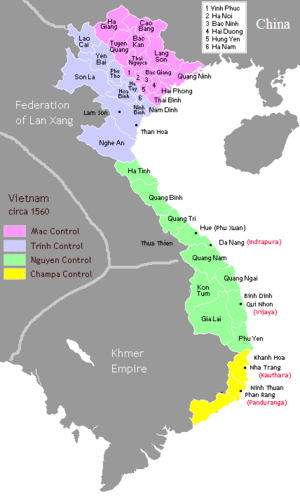
In 1558, Nguyễn Hoàng became the lord of Thuận Hóa. This event led to Vietnam being split. The Trịnh family ruled the North, and the Nguyễn family ruled the South. Both families recognized the Lê emperors, but they held the real power in their own areas. The official split between the two families began in 1627.
Nguyễn Phúc Lan made Phú Xuân (now Huế) his home in 1636. This established the Nguyễn lords' power in the South.
Nguyễn-Trịnh Conflicts
Nguyễn Hoàng and his family started to fight with the Trịnh lords. The Nguyễn lords refused to pay taxes to the government in Hanoi. They wanted to rule their own area. They expanded their land into parts of Cambodia and Laos. They also took over the last parts of the Champa kingdom in 1693. The Nguyễn lords ruled without interruption until 1776.
The Tây Sơn–Nguyễn War (1771–1802)
After a long period of peace, the Nguyễn lords faced a new challenge: the Tây Sơn rebellion in 1774. The Nguyễn army was weakened and couldn't stop the revolt. The Trịnh lords joined forces with the Tây Sơn rebels and captured Huế in 1775.
The End of the Nguyễn Lords
Nguyễn Phúc Thuần, the Nguyễn lord, fled south. In 1777, a large Tây Sơn army attacked and captured Gia Định (near modern-day Ho Chi Minh City). The Tây Sơn were popular because they promised to restore the Lê dynasty. They executed almost all members of the Nguyễn family they captured.
Nguyễn Ánh's Escape
In 1775, 13-year-old Nguyễn Ánh escaped. He got help from a Catholic priest and met a French missionary named Pigneau de Behaine. Both avoided capture by the Tây Sơn. Pigneau de Behaine decided to help Ánh, who claimed to be the rightful heir to the Nguyễn lordship.
Ánh quickly built an army and recaptured Gia Định in December 1777. But the Tây Sơn returned and took it back. Ánh's forces grew to 30,000 soldiers by 1781. However, in March 1782, the Tây Sơn defeated Ánh's army. Ánh fled to Cambodia.
Help from China and France
Nguyễn Ánh received support from Chinese Vietnamese people. Many Chinese had moved to southern Vietnam and were welcomed by the Nguyễn lords. The Tây Sơn treated ethnic Chinese badly, which made them support Ánh.

Ánh also sought help from Siam (Thailand). King Rama I of Siam agreed to help. In 1784, Siamese forces attacked Vietnam. But in December, the Tây Sơn army, led by Nguyễn Huệ, defeated them in a major battle. Ánh was forced to flee to Thailand.
Ánh then turned to France for help. He sent his oldest son, Nguyễn Phúc Cảnh, with Pigneau de Behaine to meet King Louis XVI of France. In 1787, they signed the Treaty of Versailles. France promised to send ships and soldiers. However, due to the French Revolution, France never sent the promised help. Still, de Behaine gathered French businessmen and raised money to buy weapons for Ánh. About twenty Frenchmen joined Ánh's army. They helped train his soldiers and improve his defenses.
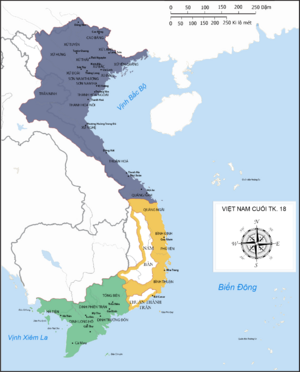
The Tây Sơn Dynasty Falls
In 1787, Nguyễn Ánh recaptured Gia Định. The Tây Sơn leader, Nguyễn Huệ, died in 1792. His son, Nguyễn Quang Toản, became emperor but was a weak leader. Nguyễn Ánh began a new campaign against Quang Toản in 1793. Quang Toản lost many battles. In 1799, Ánh captured Quy Nhơn. He then took the capital, Phú Xuân (Huế), on May 3, 1801. Quang Toản fled north.
On July 20, 1802, Ánh captured Hanoi, ending the Tây Sơn dynasty. He then executed all members of the Tây Sơn royal family.
The Nguyễn Dynasty's Independent Rule (1802–1883)
This period is known as the independent rule of the Nguyễn dynasty. Vietnam became a powerful country in Southeast Asia.
A New Emperor and New Policies
Nguyễn Phúc Ánh united Vietnam after 300 years of division. He was crowned emperor in Huế on June 1, 1802. He took the name Gia Long. This name combined "Gia" (from Gia Định in the south) and "Long" (from Thăng Long in the north) to show the country was now one. Gia Long focused on defending the nation and preventing another civil war. He based his government on Confucianism, a system of beliefs from China.
Gia Long was friendly with Western countries. But after he died in 1819, his son, Minh Mạng, became emperor. Minh Mạng ruled from 1820 to 1841. He was a conservative ruler who followed Confucian ideas. He decided to isolate Vietnam from the rest of the world for nearly 40 years. He also restricted Catholicism and other religions. This led to many rebellions during his rule.
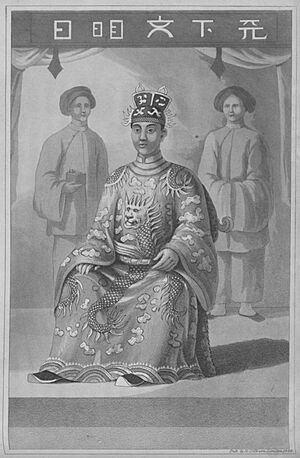
Minh Mạng expanded Vietnam's land into modern-day Laos and Cambodia. In 1834, Vietnam fully took over Cambodia and called it Tây Thành Province. Minh Mạng tried to make Cambodians adopt Vietnamese culture. But Vietnamese rule in Cambodia didn't last long. Minh Mạng died in 1841, and a Cambodian uprising began.
Decline and French Invasion
The next emperors, Thiệu Trị (1841–1847) and Tự Đức (1847–1883), faced many problems. A terrible cholera outbreak in the 1840s killed about 8% of Vietnam's people. The country's isolationist policies also hurt the economy.
From 1802 to 1862, there were 405 rebellions by peasants and others. This made it hard for the government to deal with European powers.
In September 1858, France and Spain attacked Đà Nẵng. They were protesting the execution of two Spanish missionaries. Seven months later, they attacked Saigon. The French and Spanish troops held Saigon for two years. Emperor Tự Đức decided to give up three southern provinces to France to deal with other rebellions.
In June 1862, the Treaty of Saigon was signed. Vietnam lost three southern provinces, which became French Cochinchina. This treaty was seen as a great humiliation for Vietnam. Tự Đức tried to change the treaty, but France kept taking more land. By 1867, France had annexed more provinces.

The End of Independence (1874–1885)
By the late 1860s, northern Vietnam became a dangerous place with pirates and rebels. The Vietnamese government was too weak to fight them. In 1873, a French merchant was stopped by local officials in Hanoi. The French government in Cochinchina responded by sending an army. A French army led by Francis Garnier arrived in November. The French and their allies attacked Hanoi. Tự Đức tried to negotiate, but a Vietnamese prince and Chinese Black Flags militia fought the French. Garnier was killed in December 1873.
A peace agreement was reached in 1874. France recognized Vietnam's independence from China. But Vietnam had to give France access to ports and allow trade. Vietnam also had to recognize the six southern provinces as French territory.
In 1882, France sent another expedition to the north. They took Hanoi without a fight. Tự Đức asked China for help. China sent 30,000 troops into northern Vietnam. The Black Flags also returned and attacked the French. In May 1883, the Black Flags killed the French leader, Henri Rivière. France decided to conquer Vietnam. Thousands of French and Chinese soldiers poured into Vietnam.
Emperor Tự Đức died in July 1883. A struggle for the throne followed. One nephew, Dục Đức, was emperor for only three days before being removed. Another, Hiệp Hòa, became emperor but was also removed.
France attacked Huế directly. On August 25, 1883, a treaty was signed. Vietnam gave up more land, and northern Vietnam became a French Protectorate. In November, Emperor Hiệp Hòa was removed. A 14-year-old, Kiến Phúc, became emperor. In 1884, another treaty confirmed French control over Vietnam. By June 9, 1885, Vietnam was no longer an independent state.
A Vietnamese leader, Tôn Thất Thuyết, started a rebellion against the French in July 1885. He called on people to fight for independence. This movement lasted for 11 years.
French Protectorates (1883–1945)
After the 1883 and 1884 treaties, the Nguyễn dynasty only ruled in name. Vietnam was divided into French protectorates: Annam (Central Vietnam) and Tonkin (Northern Vietnam). These were combined with Cochinchina and Cambodia in 1887 to form French Indochina.
French rule brought new things to Vietnam, like Catholicism and a Latin-based writing system for Vietnamese.
World War I and II
During World War I, France used Vietnam's resources and people to help with the war. Vietnam had to provide 70,000 soldiers and 70,000 workers. They also contributed money and food. These demands were hard on the Vietnamese people.
In May 1916, the 16-year-old emperor Duy Tân tried to join an uprising against the French. But the French found out and stopped it. Duy Tân was removed from power and sent away.
Nationalist feelings grew in Vietnam, especially after World War I. But efforts to gain independence from France failed.
World War II began in 1939. Japan invaded Vietnam in September 1940. They wanted to build military bases to fight Allied forces. Japan occupied Indochina, working with the French government that was allied with Germany. During this time, the Viet Minh, a resistance movement, grew under Ho Chi Minh. A terrible famine in northern Vietnam from 1944–1945 killed over one million people.
The Empire of Vietnam (1945)
In March 1945, Japan overthrew the French administration in Vietnam. They declared independence for Vietnam, Laos, and Cambodia. Vietnam became the Empire of Vietnam with Bảo Đại as its emperor. This was a "puppet state," meaning Japan controlled it.
After Japan surrendered in World War II, Bảo Đại gave up his throne on August 25, 1945. This happened after the Viet Minh launched the August Revolution. This event officially ended the 143-year rule of the Nguyễn dynasty.
How the Nguyễn Dynasty Was Governed
The Nguyễn dynasty had a system of government that was similar to earlier dynasties.
The Emperor's Role
The emperor was the absolute ruler of Vietnam. He was the head of both the state and the government. The Gia Long Code of 1812 said that the Vietnamese monarch was the ruler of all Vietnam. This was based on the Confucian idea of the "Mandate of Heaven." This idea meant that the ruler was chosen by heaven to lead the kingdom.
Emperor Gia Long even called his empire Trung Quốc (Middle Kingdom). This term usually refers to China. He used it to show his high status and to suggest that China was not as important. However, over time, the idea of the emperor having absolute power started to fade. When Emperor Tự Đức gave up southern Vietnam to France, many officials ignored him and kept fighting. They saw him as weak.
After the 1884 Treaty of Huế, the French took more control. They appointed their own officials. The French Resident-Superior in Huế gained more power over the imperial court. By 1897, this official could even choose the Nguyễn dynasty emperors. This meant the French were directly involved in the Vietnamese government.
In 1898, the French government took over the Nguyễn dynasty's finances. The emperor became like a salaried employee of the French. This greatly reduced his power.
Government Officials and Ranks
The Nguyễn dynasty had a system of government officials called mandarins. They had different ranks, from the highest (First Rank) to the lowest (Ninth Rank). These ranks determined their pay and responsibilities.
The government had six main ministries:
- Ministry of Personnel (for government jobs)
- Ministry of Rites (for ceremonies and education)
- Ministry of Justice (imperial China) (for laws)
- Ministry of Finance (for money)
- Ministry of Public Works (for building projects)
- Ministry of Defense (for the military)
Taxes and Wages
Officials received their wages in quan (a currency unit) and rice. For example, a First Rank official received 400 quan and 300 kg of rice. People also paid a per-capita tax.
When mandarins retired, they received money from the emperor. The imperial court also provided money for funerals when they died.
Education System
The Nguyễn dynasty had a traditional education system based on Confucianism. Students studied classic texts and took exams to become government officials.

The French later introduced their own colonial schools, teaching subjects like geography and tailoring.
Administrative Divisions of Vietnam
The Nguyễn dynasty organized Vietnam into different administrative units.
Divisions Under Gia Long
Under Emperor Gia Long, the kingdom was divided into 23 protectorates and 4 military departments. These were overseen by powerful "Viceroys." For example, the North had a Viceroy in Hanoi, and the South had one in Saigon.
Divisions Under Minh Mạng and Later
In 1831, Minh Mạng reorganized the kingdom into 31 provinces. Each province had smaller areas like prefectures and districts. The smallest unit was the village.
Two nearby provinces were often grouped together under a governor-general and a governor. By the 1840s, Vietnam had 72 prefectures and 283 districts. Cambodia was even absorbed into the Vietnamese system for a time.
Society and Culture
The Nguyễn dynasty had a unique society and culture, with specific views on different ethnic groups and religions.
Cultural Views and Discrimination
The Nguyễn dynasty saw themselves as the "Central Kingdom" (Trung Quốc). They sometimes viewed other cultures, including the Chinese under the Qing dynasty, as less civilized. They even tried to make Cambodians adopt Vietnamese customs, like wearing trousers instead of skirts.
Vietnamization of Ethnic Minorities
Under Emperor Minh Mạng, there was a policy to make ethnic minorities more like the Vietnamese. He used the term "Han people" to refer to the Vietnamese. He wanted "barbarian habits" to disappear and for people to adopt "Han [Sino-Vietnamese] customs." These policies targeted groups like the Khmer and hill tribes.
Chinese migrants in Vietnam were called Minh Hương (those who came earlier and mixed with Vietnamese) or Thanh nhân (newer arrivals). The Minh Hương were treated more like Vietnamese.
Clothing Styles
The Nguyễn dynasty made clothing styles popular that were influenced by Chinese fashion. Trousers and tunics became common. The áo dài, a traditional Vietnamese dress, developed from these styles in the 1920s.
Religion in Vietnam
While earlier Nguyễn lords were Buddhist, Emperor Gia Long was not. He favored Neo-Confucianism and limited Buddhism. Scholars criticized Buddhism as superstitious. New Buddhist temples were forbidden. Buddhist monks and nuns were sometimes forced to do public work. However, Buddhism remained popular, especially among empresses and princesses.
Confucianism was the main belief system of the Nguyễn court. It guided education and government exams. Confucian rituals were important, like prayers for rain during droughts.
Catholicism was allowed peacefully during Gia Long's rule. But Emperor Minh Mạng saw Christianity as a threat. He believed it rejected ancestor worship, which was important to the Vietnamese monarchy. He also worried that Christianity was a way for Europeans to take over countries. He began persecuting Christians, destroying churches, and imprisoning many. This persecution became even stronger under Emperor Tự Đức.
Despite this, many Catholic scholars held high positions in the court. After 1862, Catholicism was officially recognized and protected. By the late 1800s, there were about 600,000 to 700,000 Catholic Christians in Vietnam.
Population and Diversity
Before the French arrived, Vietnam's population was not very dense. In 1802, there were 6.5 million people, growing to 8 million by 1840. After the 1860s, the population grew quickly, and more people moved to cities to work in French factories. By 1880, the population was estimated to be around 12.2 million.
Vietnam under the Nguyễn dynasty was home to many different ethnic groups. About 80% were ethnic Vietnamese. The rest included Cham, Chinese, Khmer, Mường, Tày, and other minority groups.
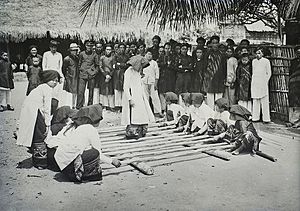
Chinese people mainly lived in cities like Saigon and Hanoi. They were divided into two groups: Minh Hương (older Chinese migrants who had mixed with Vietnamese) and Thanh nhân (newer arrivals).
Symbols of the Nguyễn Dynasty
The Nguyễn dynasty used many symbols to represent their power and the state.
Flags
The Nguyễn dynasty's national flag was usually yellow with red stripes, or sometimes just plain yellow or white. The emperor's personal flag showed a golden dragon spitting fire, with clouds, a silver moon, and a black crescent on a yellow background.
Seals

The Nguyễn dynasty used many different types of seals. These seals had strict rules about how they were used. They were made from materials like jade, bronze, silver, gold, ivory, and even meteorite. Over 100 imperial seals were created during the dynasty's 143 years.
Sun, Moon, and Yin-Yang
Like China and Korea, Vietnam used the sun as a symbol of the Empire. The moon and the Taijitu (Yin-Yang symbol) represented the State. The sun symbol was often shown as a flaming disc with pointed rays. The moon symbolized the state, the sun the empire, stars the rulers, and clouds the heaven.
The "Achievement of the Empire" showed two dragons surrounding a flaming sun. The "Achievement of the State" often showed two dragons surrounding a moon or a Taijitu. These symbols were found on the caps of high-ranking officials.
Dragons
Dragons were very important symbols during the Nguyễn dynasty. They appeared on imperial documents, coins, buildings, and the uniforms of the Imperial Guard. Five-clawed dragons were symbols of the Emperor, showing his high status. Four-clawed dragons were used for vassals and princes.
Images for kids
-
French warships Siege of Tourane (Đà Nẵng), September 1858.
-
The capture of Ninh Bình by Aspirant Hautefeuille and his sailors.
-
Huế city drawing in 1875.
Imperial Family
The Nguyễn Phúc family started in the 1300s. They ruled southern Vietnam from 1558 to 1777. Then, they became the ruling family of all Vietnam. Princes and male descendants of Gia Long were called Hoàng Thân.
List of Nguyễn Emperors
Here are the emperors of the Nguyễn dynasty, with their special era names. These names often had meanings in Chinese and Vietnamese. For example, Gia Long's name combined parts of old names for Saigon and Hanoi. This showed the country was now united.
| Portrait/Photo | Temple name | Posthumous name | Personal name | Lineage | Reign | Regnal name | Tomb | Key Events |
|---|---|---|---|---|---|---|---|---|
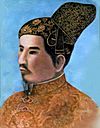 |
Thế Tổ | Khai Thiên Hoằng Đạo Lập Kỷ Thùy Thống Thần Văn Thánh Vũ Tuấn Đức Long Công Chí Nhân Đại Hiếu Cao Hoàng Đế | Nguyễn Phúc Ánh | Nguyễn lords | 1802–20 (1) | Gia Long | Thiên Thọ lăng | United Vietnam after defeating the Tây Sơn. |
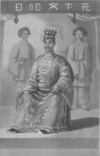 |
Thánh Tổ | Thể Thiên Xương Vận Chí Hiếu Thuần Đức Văn Vũ Minh Đoán Sáng Thuật Đại Thành Hậu Trạch Phong Công Nhân Hoàng Đế | Nguyễn Phúc Đảm | Son | 1820–41 (2) | Minh Mệnh (Minh Mạng) | Hiếu Lăng | Expanded the empire and suppressed Christianity. |
| Hiến Tổ | Thiệu Thiên Long Vận Chí Thiện Thuần Hiếu Khoan Minh Duệ Đoán Văn Trị Vũ Công Thánh Triết Chượng Chương Hoàng Đế | Nguyễn Phúc Miên Tông | Son | 1841–47 (3) | Thiệu Trị | Xương Lăng | Continued isolationist policies. | |
 |
Dực Tông | Thể Thiên Hanh Vận Chí Thành Đạt Hiếu Thể Kiện Đôn Nhân Khiêm Cung Minh Lược Duệ Văn Anh Hoàng Đế | Nguyễn Phúc Hồng Nhậm | Son | 1847–83 (4) | Tự Đức | Khiêm Lăng | Faced French invasions and lost Cochinchina. |
 |
Cung Tông | Huệ Hoàng Đế | Nguyễn Phúc Ưng Chân | Nephew (adopted son of Tự Đức) | 1883 (5) | Dục Đức | An Lăng | Ruled for only three days. |
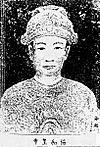 |
– | Văn Lãng Quận Vương | Nguyễn Phúc Hồng Dật | Uncle (son of Thiệu Trị) | 1883 (6) | Hiệp Hòa | Ruled for four months before being removed. | |
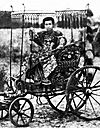 |
Giản Tông | Thiệu Đức Chí Hiếu Uyên Duệ Nghị Hoàng Đế | Nguyễn Phúc Ưng Đăng | Nephew (son of Hiệp Hòa's brother) | 1883–84 (7) | Kiến Phúc | Bồi Lăng (within Khiêm Lăng) | Ruled for eight months. |
 |
– | — | Nguyễn Phúc Ưng Lịch | Younger brother | 1884–85 (8) | Hàm Nghi | Thonac Cemetery, France | Resisted French rule. |
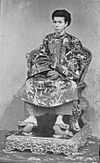 |
Cảnh Tông | Hoằng Liệt Thống Thiết Mẫn Huệ Thuần Hoàng Đế | Nguyễn Phúc Ưng Kỷ | Older brother | 1885–89 (9) | Đồng Khánh | Tư Lăng | Helped suppress the resistance movement. |
 |
– | Hoài Trạch Công | Nguyễn Phúc Bửu Lân | Cousin (son of Dục Đức) | 1889–1907 (10) | Thành Thái | An Lăng | Exiled for anti-French actions. |
 |
– | — | Nguyễn Phúc Vĩnh San | son | 1907–16 (11) | Duy Tân | An Lăng | Rebelled against the French and was exiled. |
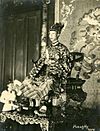 |
Hoằng Tông | Tự Đại Gia Vận Thánh Minh Thần Trí Nhân Hiếu Thành Kính Di Mô Thừa Liệt Tuyên Hoàng Đế | Nguyễn Phúc Bửu Đảo | Cousin (son of Đồng Khánh) | 1916–25 (12) | Khải Định | Ứng Lăng | Collaborated with the French. |
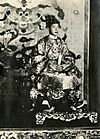 |
— | — | Nguyễn Phúc Vĩnh Thụy | Son | 1926–45 (13) | Bảo Đại | Cimetière de Passy, France | Last emperor, gave up his throne in 1945. |
See also
 In Spanish: Dinastía Nguyễn para niños
In Spanish: Dinastía Nguyễn para niños






